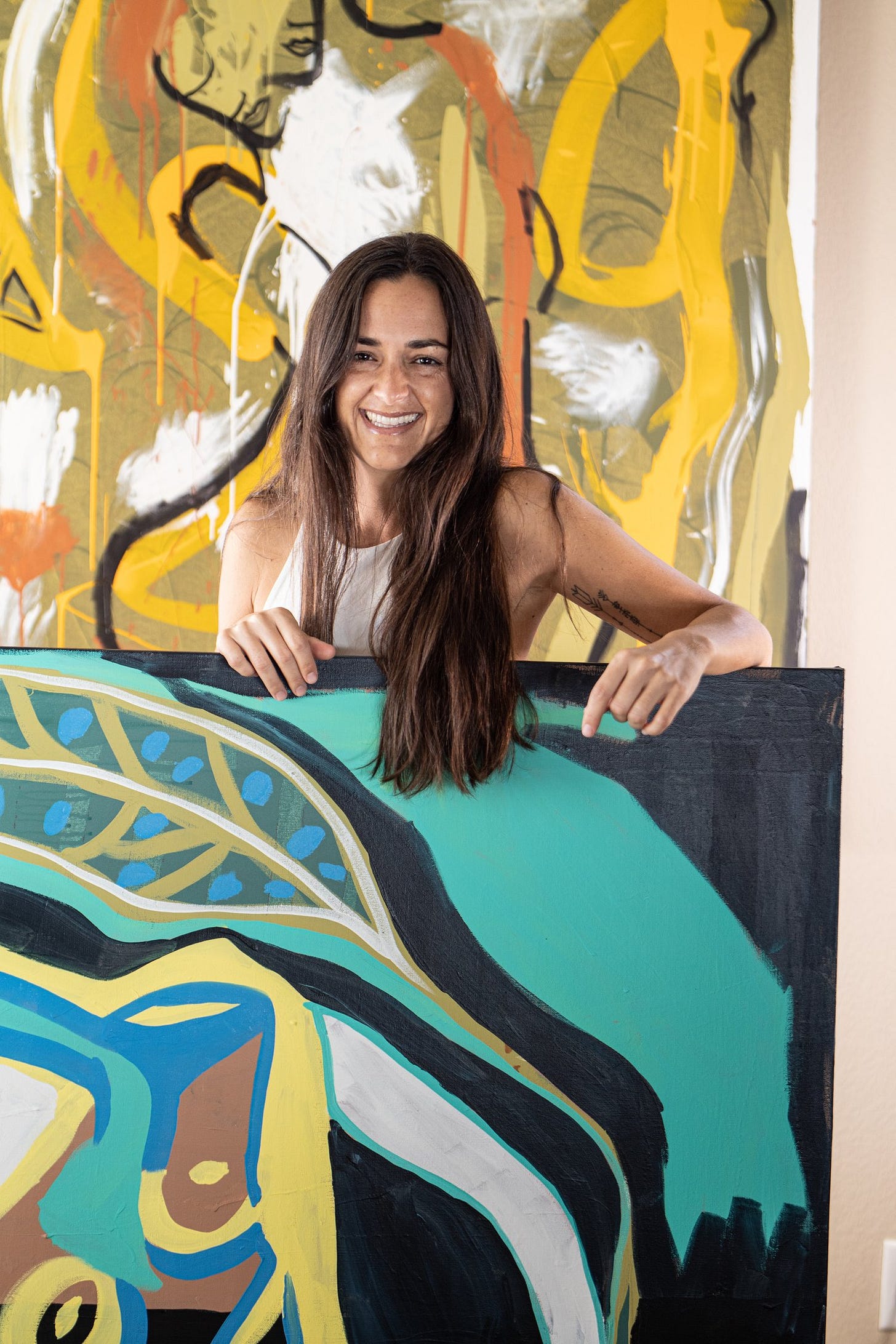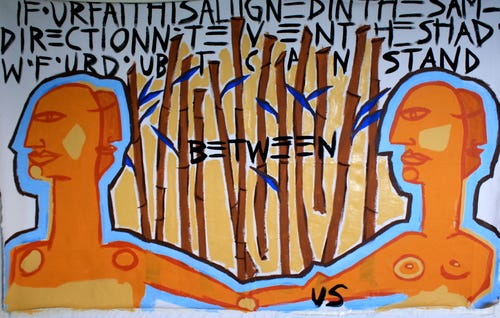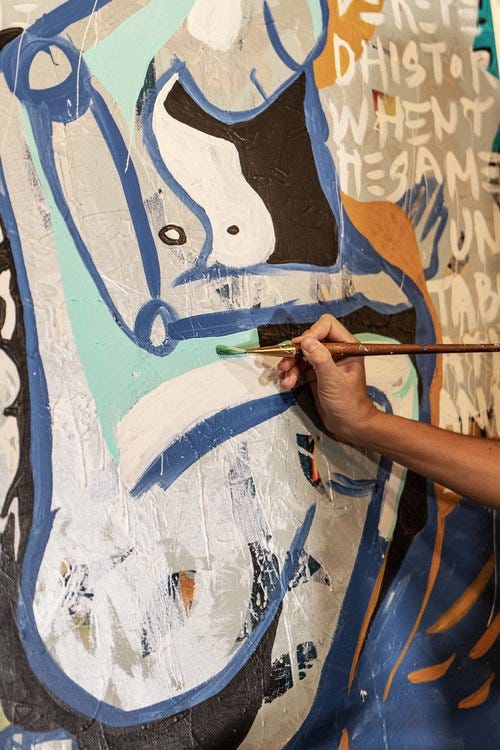In the realm of art therapy and spiritual exploration, few voices speak with the raw authenticity and depth of Paula Gasparini. A self-proclaimed "lover of truth," Paula's work transcends traditional boundaries between art, therapy, and spiritual practice, creating spaces where healing and transformation naturally emerge.
"I don't prescribe to any specific tradition - I'm not Eastern or Western, Christian or Buddhist," Paula reflects. "I'm simply a lover of truth." This truth-seeking has led her to study extensively across religious and philosophical traditions, from the Book of Mormon to the Bhagavad Gita, always searching for the common thread that connects them all. "Within all religions I've studied, I've found the same essence - interconnection, love, and unity."
The Art of Emptiness
Perhaps Paula's most profound insights come not from ancient texts but from her intimate understanding of grief. "I have a deep philosophical theory that the avenue to truth is through grief," she explains, quickly clarifying that she doesn't define grief merely as loss. "I define it as an encounter with the unknown. Our first experience of loss, whether of a person, safety, or connection, was our first entry into the unknown. From that space, we develop entire coping mechanisms to prevent us from touching that void."
This understanding has deeply informed her work, particularly in correctional facilities where she recently completed what she describes as "one of the most beautiful projects I've yet done in my career." Working alongside incarcerated artists at Madison Institution, Paula helped establish a two-week intensive art therapy program. Rather than positioning herself as an expert, she approached the work laterally, recognizing the expertise already present in the incarcerated artists themselves.
"I always try to enter any relationship - whether business, therapeutic, or artistic - as empty as I can be," she explains. "I'm trying to remove all bias, all agenda. What helps us all as humans is feeling connected, feeling seen, and feeling that thread of truth, which I believe to be the interconnection of all things."
Transformation Through Creation
This philosophy manifests powerfully in her artwork, particularly in a monumental 17-foot canvas that represents her history of trauma. The piece culminates in an image of a woman offering a peace lily to the past - a moment Paula describes as transformative. "It was the first time I understood grace. Until then, I always thought trauma was something we had to heal from. But through understanding grief as intimacy with the unknown, I discovered it was something to simply say thank you to, allowing the whole story to be what it was without having to turn it into anything else."
Paula's artistic process mirrors her philosophical approach to life - a delicate balance between creation and destruction. "All art is a balance of de-creation with creation simultaneously," she notes. "The de-creation, which is what I call grief, is as essential as the creative act itself." This interplay between building up and breaking down creates a space where authentic expression can emerge.
Redefining Hope
One of Paula's most striking pieces, "Give Me Hope and I'll Give You Anything," explores the complex relationship between hope and fear. The work, split across two canvases, represents a profound shift in her understanding of hope itself. "I used to think of hope as a huge part of my prison," she reveals. "That form of hope was actually just the other face of fear - it was where I was unwilling to face the things I was afraid of.
"
Looking at the piece now, she sees "so much love for my little survival self that was trying to overcome all the pain she had inside of her." This evolution in perspective reflects a larger truth in Paula's work: that genuine transformation often requires us to release our attachment to conventional forms of comfort.
The Safety in Vulnerability
Paula's approach to both art and therapy centers on creating space for authentic expression and connection. "The truest protection we have is that energy that is eternal - that's the thing that can't be lost," she reflects. "If you really review your life, these self-protection strategies we all implement never actually protect us from harm. Harm is inevitable. Pain is inevitable. The truest protection is having so much connection to that eternal energy that our ability to regenerate after pain becomes natural, like nature itself."
This understanding transforms her approach to working with clients and creating art. "Security and safety are vastly different," she explains. "Security means being free from care and comfortable - that's what people seek but will never find. Safety is homeless, found in that space where we've taken our compost - the good and the bad - and we've made it all one, so there's nothing to escape or fear anymore."
A Container for Transformation
Her recent exhibition "From Grief to Grace" embodied these principles, creating what she describes as "a beautiful container for the Tallahassee community." The show became a space where grief could transform into love before her eyes, witnessed in "people's words and people's eyes." The exhibition demonstrated the power of creating spaces where vulnerability is not just accepted but celebrated as a pathway to connection.
"Let grief in," she advises those in the midst of their own transformations. "Let the heaviness hold you in enough stillness where you finally surrender all those subconscious acts - the running, the avoiding, the controlling, the grasping. Let the heaviness make you so still and just get ready to receive the most beautiful gift that grief has to offer, which I believe is the space of love."
For Paula, the path to truth isn't about accumulating knowledge or perfecting techniques - it's about becoming empty enough to receive what's already there. "Truth is in the unknown," she insists, "and our willingness to be in that space." Through her art and therapeutic practice, she continues to create spaces where others can discover this truth for themselves, finding in the void not emptiness, but abundant possibility.
[This article stems from an intimate conversation exploring the intersection of art, therapy, and spiritual truth, capturing the philosophy and practice of an artist-therapist whose work continues to transform lives through authentic connection and creative expression.]






